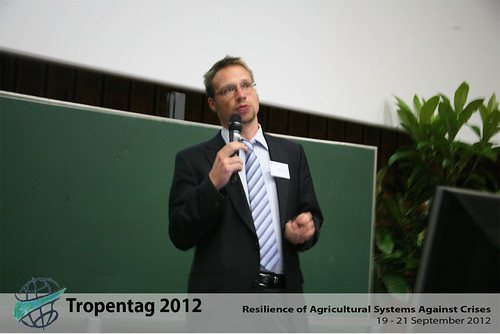tree plantations
Consider climate change in cultivar selection
Thu, 09/20/2012 - 19:05 — De-Registered User
At the oral sessions on cropping system and environment, Eike Luedeling reports about "potential fruit trees production decline induced by climate change".
 Eike Luedeling
Temperate fruit trees need winter chill in order to produce fruits. The climatic requirements during the dormancy season are poorly understood. With raising temperature production is at risk. Adaptation planning is needed in order to maintain the production.
Eike Luedeling emphasizes the need for long-term adaptation strategies. He promotes the use of the dynamic model to consider climate change in cultivar selection and to find climate analogues.
Eike Luedeling
Temperate fruit trees need winter chill in order to produce fruits. The climatic requirements during the dormancy season are poorly understood. With raising temperature production is at risk. Adaptation planning is needed in order to maintain the production.
Eike Luedeling emphasizes the need for long-term adaptation strategies. He promotes the use of the dynamic model to consider climate change in cultivar selection and to find climate analogues.
 Eike Luedeling
Temperate fruit trees need winter chill in order to produce fruits. The climatic requirements during the dormancy season are poorly understood. With raising temperature production is at risk. Adaptation planning is needed in order to maintain the production.
Eike Luedeling emphasizes the need for long-term adaptation strategies. He promotes the use of the dynamic model to consider climate change in cultivar selection and to find climate analogues.
Eike Luedeling
Temperate fruit trees need winter chill in order to produce fruits. The climatic requirements during the dormancy season are poorly understood. With raising temperature production is at risk. Adaptation planning is needed in order to maintain the production.
Eike Luedeling emphasizes the need for long-term adaptation strategies. He promotes the use of the dynamic model to consider climate change in cultivar selection and to find climate analogues. Shea trees are on the way to be domesticated
Thu, 09/20/2012 - 18:32 — De-Registered User
In the first oral presentation of the session titled " cropping system and environment", Wilfred Elegba, talks about Domestication of shea tree (Vitelleria paradoxa C. F. Gaertn) via ex-vitro propagation.
He highlights the importance of Vitelleria paradoxa, contributing up to 60 % of women's income in rural sub-Sahelian regions. Providing food (fruits, shea butter), non-food products (soaps, medicine, timber, and charcoal) and protection from erosion and desertification.
The main problems hindering domestication are the long juvenile phase (15-20 years), short seeds viability, late shoot emergency, and long tap root (transplanting difficulties). In order to enhance livelihood or rural women in northern Ghana, Mr. Elegba research objective was to develop a protocol for propagation of Shea tree.
To fasten germination and seedling growth of the trees, mechanical scarification (fruits were de-pulped and testae removed), chemical treatments (presoaks of seeds in Gibberellic acid-GA3 concentration), as well as thermo-scarification (incubation of seeds) were studied by means of trials.
The main find outs were that GA3 and thermo-scarification reduces days to seedling emergency. Testa scarification reduces radicle length compared to the control. Presoaking of seeds in 20% GA3 for 48 hours resultes in the highest mean number of leaves and seedling height.
Tropical agroforestry: learning from the past, projecting the future
Fri, 10/07/2011 - 13:48 — De-Registered User
The tropics are home to the largest share of the world's biodiversity. At the same time, they are regions where persistent poverty, population increase and climate change pose major threats to the food security of the local populations. Therefore, there are in great need of sustainable modes of land-use, which maintain diversity at all levels. This is achieved at best through multi-crop prodction systems, hence forests and agroforestry could not be missing from the international discourse for development on the margin.
This year's Tropentag covered the topic through numerous posters and oral presentations, with interesting contributions from both theory and practice.
Julia Szulecka from the Technische Universität Dresden, traced the development of historically changing assumptions, concepts, values and practices that constitute our way of viewing plantation forestry. By doing so, she drew a direct correlation between the evolution of meanings and associations related to forest plantations and the development of plantation-related policies.
 Julia Szulecka, Technische Universität Dresden
Julia Szulecka, Technische Universität Dresden
 Julia Szulecka, Technische Universität Dresden
Julia Szulecka, Technische Universität Dresden




